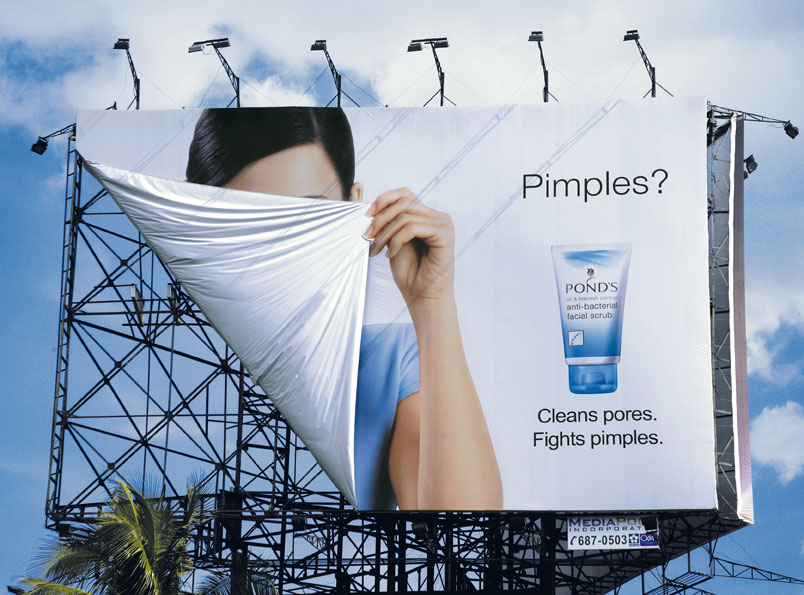Original Advertisement
Analysis
In 2007, Pond’s, a beauty and health care brand, released a creative billboard that showcased its new anti-bacterial facial scrub. The message on the billboard was pretty straightforward with just five words on the billboard. The company claims that their new facial scrub fights pimples and will also help you get clean pores. On the advertisement, there is a lady holding up the left corner of the advertisement to cover her face.
In this culture jam assignment, the problem with this advertisement that I will be addressing is the broader message that the company has conveyed through this billboard advertisement. Not only is the advertisement conveying the message that women should be ashamed of themselves for having pimples on their faces, it also alludes to a greater message that if someone is not beautiful, they should not be seen in public, correlating the value of an individual to being defined by their physical appearance. With that being said, Pond’s is projecting the wrong type of message to consumers: the advertisement claims to talk about skincare but it has an underlying message about the value of being beautiful. Furthermore, the size of the woman is much larger in scale than the skincare product itself, As a result, the woman becomes the focus of the advertisement instead of the product they are actually promoting. In a sense, the woman has become the product of the image, rather than the consumer. The advertisement is no longer selling the idea of clear skin, but the idea that women need to have clear skin and to reach this standard of beauty.
Jammed Version

Jamming Philosophy
In my edited version of the advertisement, the text is changed, and instead represents this greater message of the need to be beautiful to be accepted that I have addressed earlier. By simply changing the text on the image, it shows just how easily the advertisement can be read in a different way. With the lady on the billboard using the corner of the ad to cover her face, some people may feel as though they should somehow feel the need to cover their face if they do not have a flawless face. Furthermore, covering her face allows her to become anonymous and fluid, taking on the role of any appearance the consumer pleases and allowing her to become a reflection of the consumer’s self. Therefore the use of the subject “you” in my edited text directly addresses this problem. The advertisement is clearly targeting the insecurity of the consumer and using the subject “you”, reflecting how the advertisement targets the consumer. This evokes the discussion on how it is problematic to create standards of beauty and manifest insecurity in order to sell a product, and confronts the toxic culture cosmetic companies take advantage of as the core of their marketing strategy and communication to the consumer.
The absurdity of the advertisement can easily be overlooked if it was not my “jammed” version of it. This shows just how naturalized the culture of insecurity and beauty standards has become in our everyday lives and society in general. The underlying message is seen as a harmless advertisement because of how we as consumers are almost desensitized to being shamed by companies and how normalized this shaming of others has become.
